Chain Drive VS Drive Shaft, Is there a Big Difference?
Last updated on – Jul 30, 2016
Modern motorbikes are made up of least maintenance package, which is among the most vital issues for the current world of waist breaking dearness. However, the motorbikes now-a-days, seldom place a visit over workshops and that too for minor affairs. The major components which are required to be having attended by the owner include tyres, air pressure, carburetor, engine oil and Drive system. In India, the Chain drive is mostly seen drive system in delivering power to the rear wheel, but this is not the only thing for this purpose. The bulky and robust bikes manufactured by international brands also use other drive systems including belt drive and drive shaft. The operational motto of all these three is the same and the discrepancies lie in the final output of power.
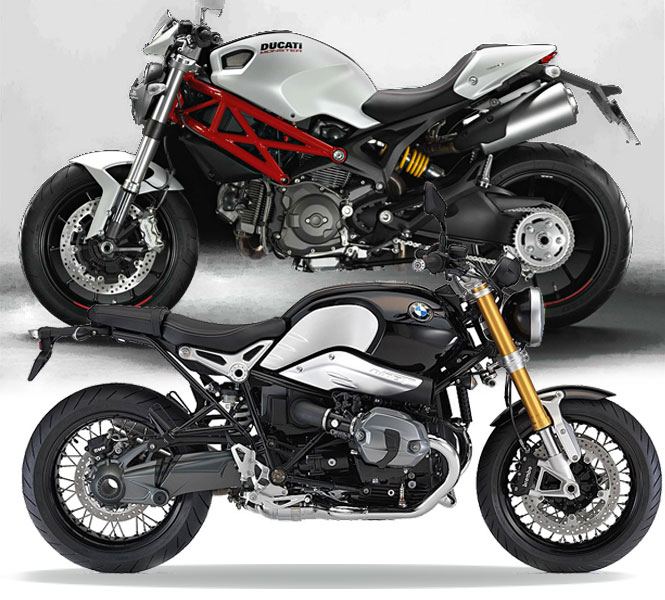
The Chain Drive and Drive Shaft are the two most commonly used drive systems. Both are having their specific purpose, advantages and disadvantages. But let us first discuss what they actually do. The Chain drive is known to most of the people that this drive system is used to connect the sprockets arranged at the rear wheel and inside the gear box. The movement of the chain decides the power generated at the rear wheel. In the case of drive shaft, a shaft used to connect the gear box with the final drive hub at the rear wheel. In both the cases, the procedure remains same while the amount of power gets differentiated.
The chain drive helps in getting higher efficiency and power generation. It is also the most utilized thing of the two in the motorbikes. However, the maintenance issues with this one is the most concerning thing. The chain system requires time to time checkup and patronage. The gearing function also works smoothly and doesn’t produce any problem while riding in the city or over the highways. The proper gear ratio happens to be getting switched optimally. The user can also look for a vast scope in the modification.
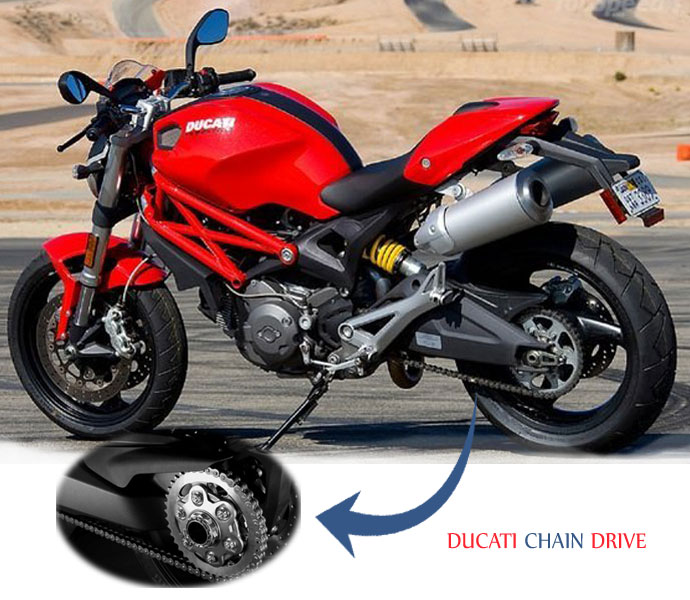
The chain system can be replaced easily with a better one or user defined system which can have more number of teeth over the sprocket. It has been seen many times in the earlier times and now, that the increase in the number of teeth and length of the belt produces better power generation and that too at the low RPM counts. This also generates high fuel efficiency and the change in the sprocket doesn’t harm or disturb the by-standing components because of the obvious reasons that the user won’t be raising the teeth count to a drastic level. One of the best example for this is the Yamaha FZ FI series, which has received a new rear wheel sprocket with 1 extra tooth than that of old FZ, making a total of 41 teeth. This has resulted into the better mileage and power generation at lower RPM. The basic thing behind the above customizability stuff is that the chain system can be easily manipulated and even repaired as well.
On the other hand, the drive shaft is not at all on the maintenance side, in fact, it doesn’t need that either. The drive shaft is a complex geometry for the repairing and modification jobs. People would hardly find a mechanic to deal with the drive shaft system, but they would seldom require one as the problems with it arise as one in a huge herd of bikes. This system also adds additional weight to the vehicle’s total mass because of the shaft, but then it also produce the most systematic and smooth riding pleasure, which one would not receive from the chain drive. As the rear assembly doesn’t bear any two way swing arm, removing and placing back the wheel during punctures and upgrades would be a tonne easier than doing this with the chain drive system.
The BMW Motorrad is the most active manufacturer of the drive shaft motorcycles. The 1923 was the era when they introduced R32, which was the first bike to run with a drive shaft and it was so wisely crafted that the concept emerged in a strikingly competitive way for the other power delivering systems.
Core Differences
So, the Chain and shaft both are equally potent with their habitants and they have performed remarkably as a momentous. But still, most of the companies are praising the chain system as the primary aspect for their products. May be the customs are not allowing them besides the fact that the shafts are not bad either. The reasons are many, which can be enumerated in the following points.
Why Chain?
- The chains are lighter than the shafts, and this is a major facet which gets reflected over the mileage of the vehicle.
- The chains are flexible and thus they get adjusted with the shocks from sudden acceleration or bad road jerks.
- The economy can be raised or manipulated with the changes in the final drive ratio with the replacement of sprocket and other parts; this is not possible with the drive shaft as the length can’t be disturbed.
- Replacing a chain is like living the life of a riley. A newbie can also perform this.
- It is much cheaper than Shaft. So replacing during tough times would be pocket friendly.
Why Shaft?
- Shafts are comparatively stronger than chains and hence, they possess a better life.
- As the chains easily catch dust and mud, the cleanliness must be retained there for smooth running. This is not the case with shaft drive and due to this it moves smoothly.
- During punctures or tyre upgradations, the removal and re fitting of tyres is very easy.
- Being so strong, the wear and tear are very minimal than chain drive.
- Drive shafts are capable to withstand heavy stretching, which chains are unable to sustain.
Chain Drive VS Drive Shaft, Is there a Big Difference?
http://www.blog.sagmart.com/wp-content/uploads/2014/09/chain-vs-shaft1-300x300.jpg Bikes Reviews and TipsLast updated on – Jul 30, 2016
Modern motorbikes are made up of least maintenance package, which is among the most vital issues for the current world of waist breaking dearness. However, the motorbikes now-a-days, seldom place a visit over workshops and that too for minor affairs. The major components which are required to be having attended by the owner include tyres, air pressure, carburetor, engine oil and Drive system. In India, the Chain drive is mostly seen drive system in delivering power to the rear wheel, but this is not the only thing for this purpose. The bulky and robust bikes manufactured by international brands also use other drive systems including belt drive and drive shaft. The operational motto of all these three is the same and the discrepancies lie in the final output of power.

The Chain Drive and Drive Shaft are the two most commonly used drive systems. Both are having their specific purpose, advantages and disadvantages. But let us first discuss what they actually do. The Chain drive is known to most of the people that this drive system is used to connect the sprockets arranged at the rear wheel and inside the gear box. The movement of the chain decides the power generated at the rear wheel. In the case of drive shaft, a shaft used to connect the gear box with the final drive hub at the rear wheel. In both the cases, the procedure remains same while the amount of power gets differentiated.
The chain drive helps in getting higher efficiency and power generation. It is also the most utilized thing of the two in the motorbikes. However, the maintenance issues with this one is the most concerning thing. The chain system requires time to time checkup and patronage. The gearing function also works smoothly and doesn’t produce any problem while riding in the city or over the highways. The proper gear ratio happens to be getting switched optimally. The user can also look for a vast scope in the modification.

The chain system can be replaced easily with a better one or user defined system which can have more number of teeth over the sprocket. It has been seen many times in the earlier times and now, that the increase in the number of teeth and length of the belt produces better power generation and that too at the low RPM counts. This also generates high fuel efficiency and the change in the sprocket doesn’t harm or disturb the by-standing components because of the obvious reasons that the user won’t be raising the teeth count to a drastic level. One of the best example for this is the Yamaha FZ FI series, which has received a new rear wheel sprocket with 1 extra tooth than that of old FZ, making a total of 41 teeth. This has resulted into the better mileage and power generation at lower RPM. The basic thing behind the above customizability stuff is that the chain system can be easily manipulated and even repaired as well.
On the other hand, the drive shaft is not at all on the maintenance side, in fact, it doesn’t need that either. The drive shaft is a complex geometry for the repairing and modification jobs. People would hardly find a mechanic to deal with the drive shaft system, but they would seldom require one as the problems with it arise as one in a huge herd of bikes. This system also adds additional weight to the vehicle’s total mass because of the shaft, but then it also produce the most systematic and smooth riding pleasure, which one would not receive from the chain drive. As the rear assembly doesn’t bear any two way swing arm, removing and placing back the wheel during punctures and upgrades would be a tonne easier than doing this with the chain drive system.
The BMW Motorrad is the most active manufacturer of the drive shaft motorcycles. The 1923 was the era when they introduced R32, which was the first bike to run with a drive shaft and it was so wisely crafted that the concept emerged in a strikingly competitive way for the other power delivering systems.
Core Differences
So, the Chain and shaft both are equally potent with their habitants and they have performed remarkably as a momentous. But still, most of the companies are praising the chain system as the primary aspect for their products. May be the customs are not allowing them besides the fact that the shafts are not bad either. The reasons are many, which can be enumerated in the following points.
Why Chain?
- The chains are lighter than the shafts, and this is a major facet which gets reflected over the mileage of the vehicle.
- The chains are flexible and thus they get adjusted with the shocks from sudden acceleration or bad road jerks.
- The economy can be raised or manipulated with the changes in the final drive ratio with the replacement of sprocket and other parts; this is not possible with the drive shaft as the length can’t be disturbed.
- Replacing a chain is like living the life of a riley. A newbie can also perform this.
- It is much cheaper than Shaft. So replacing during tough times would be pocket friendly.
Why Shaft?
- Shafts are comparatively stronger than chains and hence, they possess a better life.
- As the chains easily catch dust and mud, the cleanliness must be retained there for smooth running. This is not the case with shaft drive and due to this it moves smoothly.
- During punctures or tyre upgradations, the removal and re fitting of tyres is very easy.
- Being so strong, the wear and tear are very minimal than chain drive.
- Drive shafts are capable to withstand heavy stretching, which chains are unable to sustain.

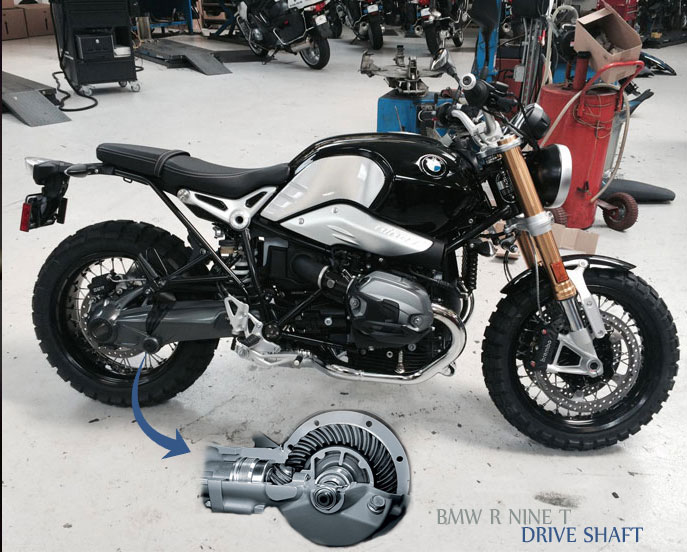
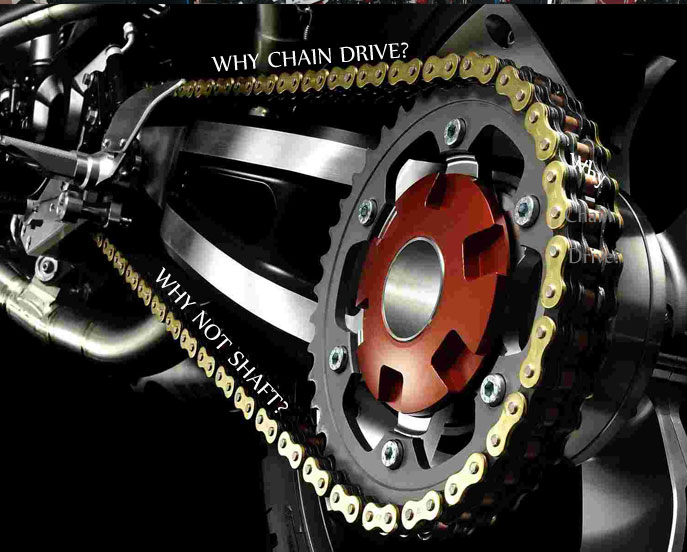
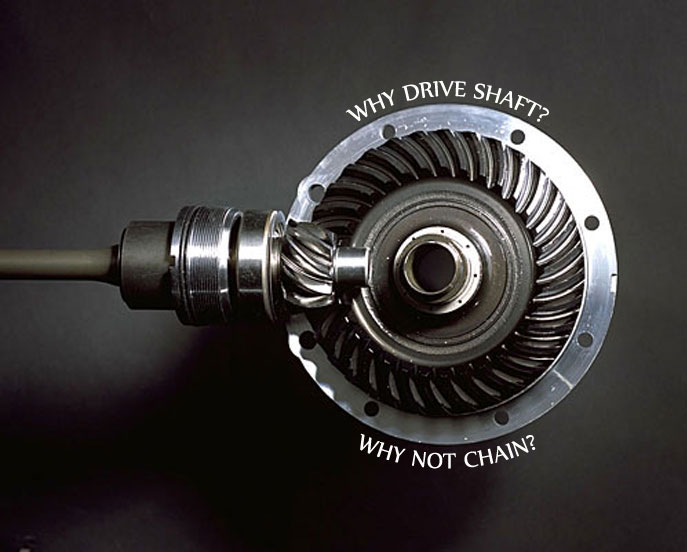
Leave a Reply